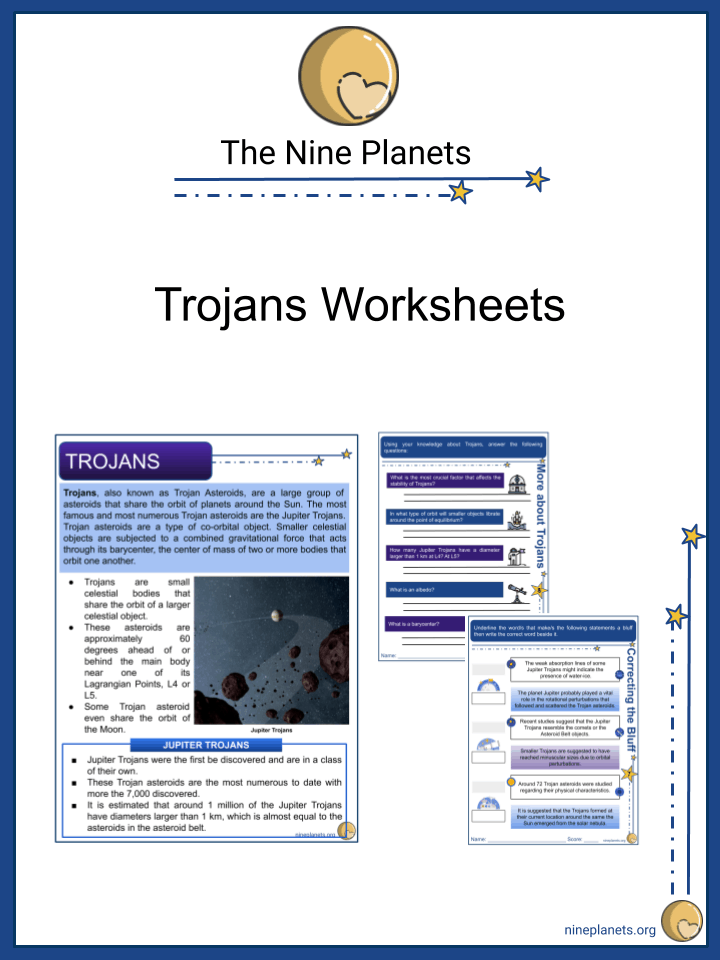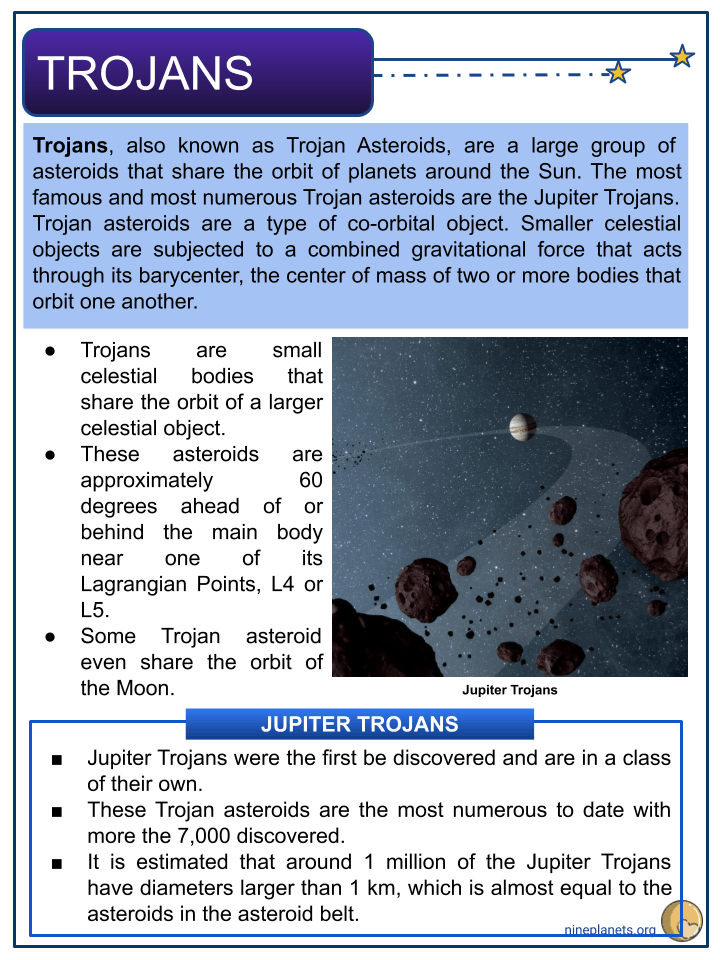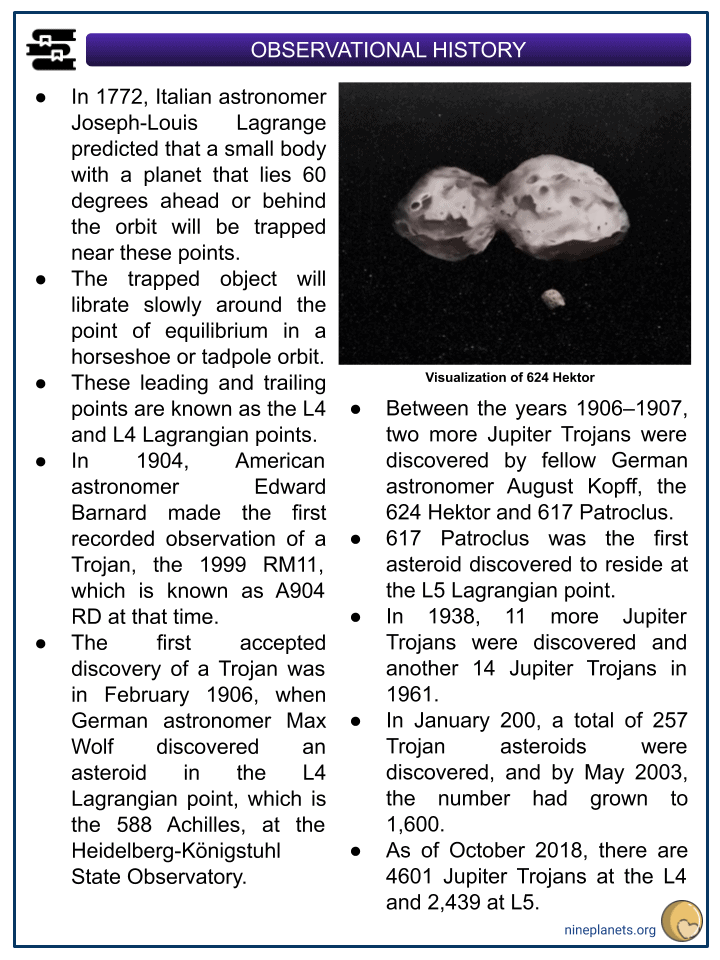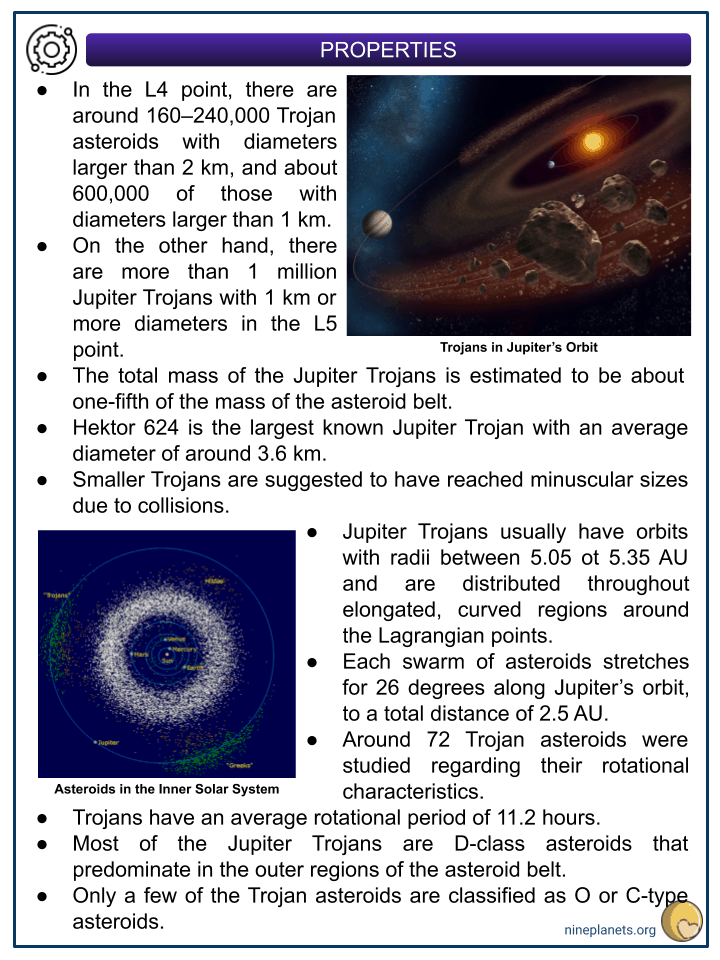Download Trojans (Asteroids) Worksheets
Click the button below to get instant access to these premium worksheets for use in the classroom or at a home.

This worksheet can be edited by Premium members using the free Google Slides online software. Click the Edit button above to get started.
Download free sample
Not ready to purchase a subscription yet? Click here to download a FREE sample of this worksheet pack.
Resource Examples
Click any of the example images below to view a larger version.




Key Facts & Information
- Trojans, also known as Trojan Asteroids, are a large group of asteroids that share the orbit of planets around the Sun. The most famous and most numerous Trojan asteroids are the Jupiter Trojans. Trojan asteroids are a type of co-orbital object. Smaller celestial objects are subjected to a combined gravitational force that acts through its barycenter, the center of mass of two or more bodies that orbit one another.
- Trojans are small celestial bodies that share the orbit of a larger celestial object.
- These asteroids are approximately 60 degrees ahead of or behind the main body near one of its Lagrangian Points, L4 or L5.
- Some Trojan asteroid even share the orbit of the Moon.
Jupiter Trojans
- Jupiter Trojans were the first be discovered and are in a class of their own.
- These Trojan asteroids are the most numerous to date with more the 7,000 discovered.
- It is estimated that around 1 million of the Jupiter Trojans have diameters larger than 1 km, which is almost equal to the asteroids in the asteroid belt.
Observational History
- In 1772, Italian astronomer Joseph-Louis Lagrange predicted that a small body with a planet that lies 60 degrees ahead or behind the orbit will be trapped near these points.
- The trapped object will librate slowly around the point of equilibrium in a horseshoe or tadpole orbit.
- These leading and trailing points are known as the L4 and L4 Lagrangian points.
- In 1904, American astronomer Edward Barnard made the first recorded observation of a Trojan, the 1999 RM11, which is known as A904 RD at that time.
- The first accepted discovery of a Trojan was in February 1906, when German astronomer Max Wolf discovered an asteroid in the L4 Lagrangian point, which is the 588 Achilles, at the Heidelberg-Königstuhl State Observatory.
- Between the years 1906–1907, two more Jupiter Trojans were discovered by fellow German astronomer August Kopff, the 624 Hektor and 617 Patroclus.
- 617 Patroclus was the first asteroid discovered to reside at the L5 Lagrangian point.
- In 1938, 11 more Jupiter Trojans were discovered and another 14 Jupiter Trojans in 1961.
- In January 200, a total of 257 Trojan asteroids were discovered, and by May 2003, the number had grown to 1,600.
- As of October 2018, there are 4601 Jupiter Trojans at the L4 and 2,439 at L5.
Properties
- In the L4 point, there are around 160–240,000 Trojan asteroids with diameters larger than 2 km, and about 600,000 of those with diameters larger than 1 km.
- On the other hand, there are more than 1 million Jupiter Trojans with 1 km or more diameters in the L5 point.
- The total mass of the Jupiter Trojans is estimated to be about one-fifth of the mass of the asteroid belt.
- Hektor 624 is the largest known Jupiter Trojan with an average diameter of around 3.6 km.
- Smaller Trojans are suggested to have reached minuscular sizes due to collisions.
- Jupiter Trojans usually have orbits with radii between 5.05 ot 5.35 AU and are distributed throughout elongated, curved regions around the Lagrangian points.
- Each swarm of asteroids stretches for 26 degrees along Jupiter’s orbit, to a total distance of 2.5 AU.
- Around 72 Trojan asteroids were studied regarding their rotational characteristics.
- Trojans have an average rotational period of 11.2 hours.
- Most of the Jupiter Trojans are D-class asteroids that predominate in the outer regions of the asteroid belt.
- Only a few of the Trojan asteroids are classified as O or C-type asteroids.
- There is no evidence of the presence of water in these asteroids, but there is a possibility that some of the Trojans might contain it.
- Recent studies suggest that the Jupiter Trojans resemble the comets or the Kuiper Belt objects regarding their composition, which is mainly water-ice with a layer of dust.
Formation
- Trojans are rare among the planets in our Solar System, excluding Jupiter.
- It is suggested that the Trojans formed at their current location around the same the Jupiter emerged from the solar nebula.
- The planet Jupiter probably played a vital role in the gravitational perturbations that followed and scattered the Trojan asteroids.
Trojan’s Stability
- The most crucial factor that affects the stability of the Trojans is the gravitational perturbations to which it is subjected.
- A planet with the same mass as Earth and another with Jupiter orbiting a star would be a stable chemistry for Trojans.
- However, Trojans’ orbit would be much less stable if the Jupiter-sized planet would have the mass of Pluto.
Other Trojans
- A lot of Trojans are thought to be captured during the early stages during the formation of the Solar System, or slightly later during the migration of the giant planets.
- The term “Trojan” originally referred to the Jovian Trojans, which orbit close to the Lagrangian points of the planet Jupiter.
- Trojans are named after the figures from the Trojan War of Greek Mythology.
- Conventionally, the ones that orbit near the L4 point of Jupiter are named for the characters from the Greek side of the war, while those on the L5 point are from the Trojan side.
- However, Trojans were later discovered around other planets.
Martian Trojans
- There are currently 4 known Martian Trojans: 5261 Eureka, (101429) 1998 VF31, (311999) 2007 NS2, and (121514) 1999 UJ7.
- Different theories were developed regarding the origin of the Martian trojans.
- It is suggested that these Trojans were primordial objects left over from the formation of the planet Mars, which were captured in its Lagrangian points as the Solar System was forming.
- Other astronomers also suggest that asteroids were chaotically wandering into the Mars Lagrangian points later during the formation of the Solar System.
Neptunian Trojans
- Neptunian Trojans are believed to outnumber the large Jovian Trojans by an order of magnitude. There are 22 Trojans discovered around Neptune. Some of these are: 2001 QR 322, 2004 KV18, 385571 Otrera, 2005 TN53, 2008 LC18 and 385695 Clete.
- The first Neptunian Trojan was discovered in 2001, the 2001 QR322, which is near the L4 region of Neptune.
- The discovery of the high-inclination Trojan 2005 TN53 in 2005 indicated that the Neptunian Trojans populate thick clouds that constrained their possible origins.
- It is suggested that the large L5 Neptunian Trojans are as common as the L4 Trojans.
Earth Trojans
- 2010 TK7 Is the first known Earth Trojan, which is located in the L4, ahead of Earth.
- 2010 TK7 was discovered in October 2010 using the Wide-field Infrared Survey Explorer (WISE) satellite.
- Theia is a hypothetical planet-sized Trojan with the size of Mars.
- It is hypothesized that the Moon formed after the collision of Earth and Theia, in which the showering material eventually accreted around Earth and into a single orbiting body.
- 2010 TK7:
- Apparent Magnitude: 20.8 to 23.6
- Absolute Magnitude: 20.8
- Eccentricity: 0.19
- Observation Arc (yr): 2.1
- Orbital Period (yr): 1
- Average Orbital Speed (m/s): 9.1
- Dimensions (m): 150-500
- Aphelion (AU): 1.19
- Perihelion (AU): 8.1
- Semi-major Axis (AU): 1
- Inclination (degree): 20.89
- Mean Anomaly (degree): 354.14
Uranian Trojans
- There are only 2 Uranus Trojans and both were also at L4: 2011 QF99 and 2014 YX49.
- 2011 QF99 is actually a minor planet from the outer Solar System.
- It was first discovered in August 29, 2011 during a deep survey of trans-Neptunian objects conducted with the Canada–France–Hawaii Telescope and was identified as a Uranus Trojan in 2013.
- 2014 YX49 is the second known Uranus Trojan, which is on a tadpole orbit with Uranus.
- It is suggested that 2014 YX49 remained as a L4 Uranian Trojan for about 60,000 years and will continue being one for another 80,00 years.
Venus Trojans
- There is only 1 known Venusian Trojan which is temporary, the 2013 ND15.
- It was discovered by Primak, Schultz, Goggia, and Chambers in July 13, 2013, during their observation for the Panoramic Survey Telescope and Rapid Response System (Pan-STARRS) project at the Haleakala Observatory in Hawaii.
Formation
- Trojan asteroids will be part of the astronomers’ focus for an extended period since only a little information is known.
- NASA has already announced a mission to explore 5 Jupiter Trojans starting in the year 2021, with the spacecraft arriving in 2027 at the L4 trojan cloud.
Did You Know?
- 617 Patroclus is the second-largest Jupiter Trojan with a diameter of 140 km.
- 4709 Ennomos is a Jupiter Trojan with the highest albedo, measure of how much light that hits a surface is reflected without being absorbed, of 0.18, which may also indicate the presence of water-ice.
- The Jupiter Trojans 911 Agamemnon and 617 Patroclus have very weak absorption of 1.7 and 2.3 μm, which might indicate the presence of organics.
- According to simulations, around 17% of the Jupiter Trojans are unstable over the age of our solar system.